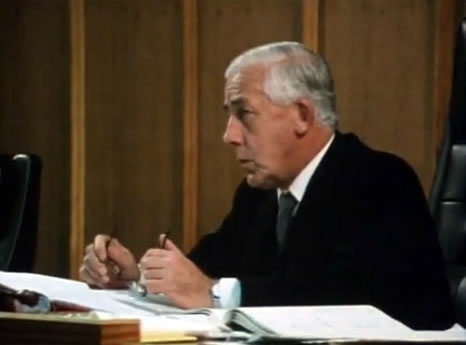
Judge Peter Mahon at the public hearings of the Royal Commission of Inquiry into the Erebus disaster.
The Inquiry and Mahon’s report
The public hearings of the Royal Commission of Inquiry into the accident began as scheduled on 7 July 1980. Justice Peter Mahon was assisted in his inquiries by two barristers, David Baragwanath and Gary Harrison, with Sir Rochford Hughes, a retired Air Marshal of the Royal Air Force, providing technical assistance. Represented by legal counsel at the hearing were:
- Air New Zealand
- The Civil Aviation Division (CAD)
- The Office of Air Accident Investigations
- The New Zealand Airline Pilots Association (NZALPA)
- The New Zealand Engineers’ Institute
- The McDonnell Douglas Corporation
- The estates of the pilot, co-pilot and Peter Mulgrew, the commentator on the flight (individually)
- The consortium representing the estates of deceased passengers
Ron Chippindale, Chief Inspector of Air Accidents, was the first of 52 witnesses examined. He was asked to expand on various aspects of his report, and was cross-examined by legal counsel. Other witnesses called during the 75 sitting days included employees of Air New Zealand, CAD, the New Zealand Meteorological Service and members of the pilots’ families. They chiefly gave evidence on:
- The route qualification briefing – what material was presented and what was said.
- The flight plan – whether the pilot plotted the route before the Antarctic flight, and the changes made to the navigational coordinates following the briefing.
- The minimum safe altitudes for Antarctic sightseeing flights in IMC and VMC conditions – were these absolute, and what did Air New Zealand know about the altitudes at which flights were actually operated.
- The visual conditions in Antarctica at the time – what was revealed by the passengers’ photographs, the cockpit voice recorder (CVR) tapes, and discussion of the polar phenomenon of white-out, a blending of pale horizon and white snow.
Gordon Vette
A number of pilots disagreed with Chippindale’s ‘probable cause’, pilot error. Chief among them was Air New Zealand Captain Gordon Vette. After rumours of a finding of pilot error began to circulate he had embarked on his own investigation. At the Inquiry he argued that the accident was a consequence of the crew’s mindset (after the route qualification briefing) and the white-out conditions (on which they had not been adequately briefed), coupled with the change in coordinates.
In addition to hearing evidence in New Zealand, Mahon travelled to the US and UK. There he and Baragwanath interviewed experts and obtained testimony from 15 witnesses who were not available to come to New Zealand, including the scientists who had analysed the CVR. From 26 to 29 November Mahon, Baragwanath, Hughes and others travelled to Antarctica, visiting the crash site and inspecting the radio, radar and air traffic control facilities at McMurdo.
Mahon had been due to report to the Governor-General by 31 October 1980, but was granted four extensions to this deadline. At the conclusion of the public hearings he had 3083 pages of evidence, 284 documentary exhibits and 368 pages of closing submissions to review. His report was submitted on 16 April 1981 and released publicly on 27 April.
In the section summarising ‘the cause of the disaster’, Mahon observed that ‘the occurrence of any accident was normally due to the existence of a variety of factors’. He asserted that in this case there were 10 factors; the disaster would not have occurred had any one of them not been present. But he then went on to describe a single cause of the disaster:
In my opinion therefore, the single dominant and effective cause of the disaster was the mistake made by those airline officials who programmed the aircraft to fly directly at Mt Erebus and omitted to tell the aircrew. That mistake is directly attributable, not so much to the persons who made it, but to the incompetent administrative airline procedures which made the mistake possible.
He disagreed with Chippindale’s ‘probable cause’ that the pilot was at fault, and cleared the crew of any responsibility for the accident. The blame lay squarely with Air New Zealand.
Mahon also claimed that the airline’s executives and management pilots had engaged in a conspiracy to whitewash the enquiry, accusing them of covering up evidence and misleading investigators through ‘an orchestrated litany of lies’. He ordered Air New Zealand and CAD to pay the costs incurred by the consortium, NZALPA, and the estates of the pilot and co-pilot. He also ordered the airline to pay $150,000 9equivalent to $600,000 in 2013) towards the government’s costs.
His conclusions, including his criticisms of CAD, were widely reported over the following days. But the focus, and the headlines, went on Air New Zealand.
Next page: Resignations and court action
Further information
- Captain Vette’s research (NZALPA’s Erebus website)
- Mahon report (NZALPA’s Erebus website)
- The CVR transcript (NZALPA’s Erebus website)

Community contributions